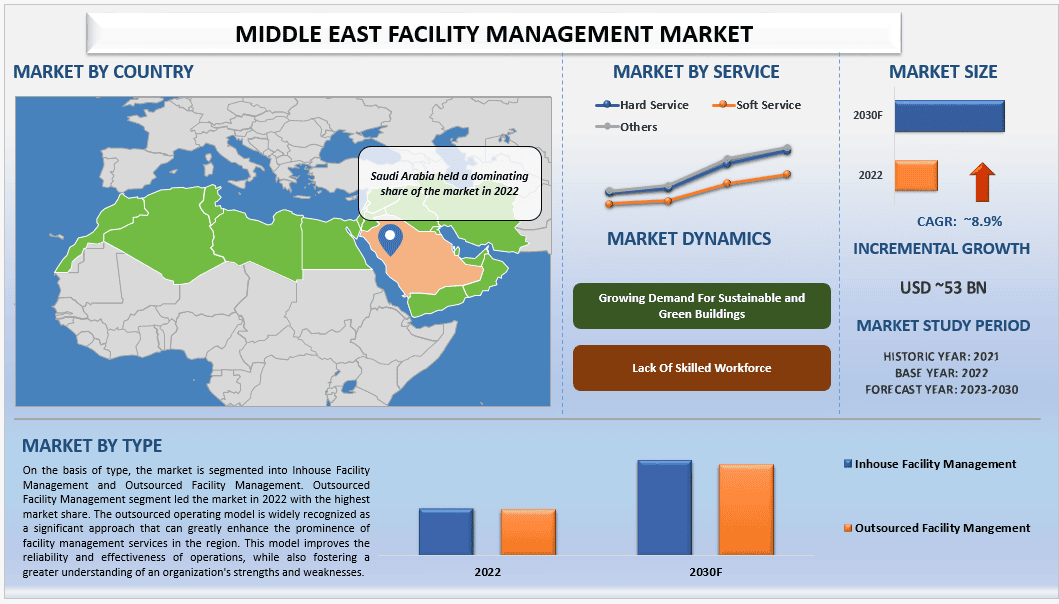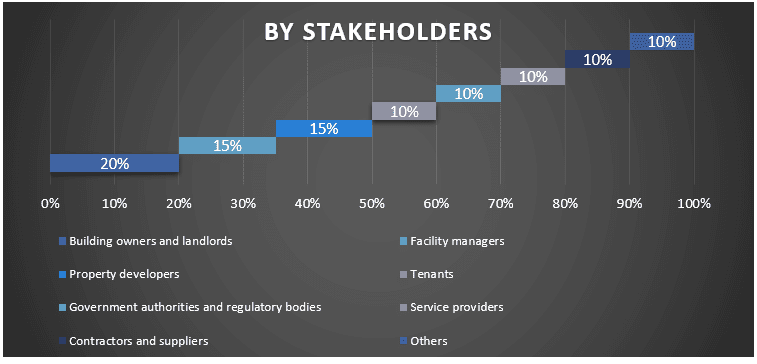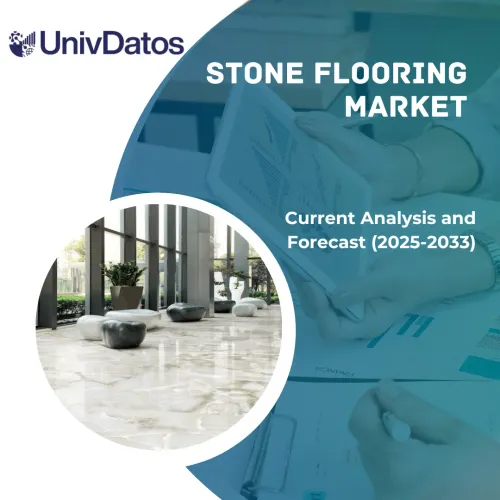- Strona główna
- O nas
- Branża
- Usługi
- Czytanie
- Kontakt
Rynek Facility Management na Bliskim Wschodzie: Analiza bieżąca i prognoza (2023-2030)
Nacisk na usługi (Usługi twarde, Usługi miękkie i inne); Rodzaj (Wewnętrzne Zarządzanie Obiektami i Outsourcing Zarządzania Obiektami); i Użytkownicy Końcowi (Komercyjne, Mieszkaniowe, Rządowe, Edukacyjne, Opieka Zdrowotna i inne); Kraj
Geografia:
Przemysł:
Ostatnia aktualizacja:
Oct 2023

Wartość rynku Facility Management na Bliskim Wschodzie wyniosła 53 miliardy USD w 2022 roku i oczekuje się, że w okresie prognozy (2023-2030) będzie rósł w silnym tempie CAGR wynoszącym około 8,9%. Rynek facility management na Bliskim Wschodzie odnotowuje znaczny wzrost ze względu na rosnące zapotrzebowanie na efektywne i opłacalne zarządzanie budynkami komercyjnymi i mieszkalnymi. Rynek facility management na Bliskim Wschodzie jest napędzany przez czynniki, takie jak rosnący sektor nieruchomości, szybka urbanizacja i rosnące wykorzystanie zaawansowanych technologii. Rządy w regionie koncentrują się na poprawie infrastruktury i inwestowaniu w inicjatywy dotyczące inteligentnych miast, co stworzyło sprzyjające środowisko dla branży facility management. Rynek jest wysoce konkurencyjny, z kilkoma lokalnymi i międzynarodowymi graczami działającymi w regionie. Kluczowi gracze to EFS Facilities Services Group, Emrill Services LLC, Khidmah LLC i Imdaad. Firmy te oferują szeroki zakres usług, w tym konserwację, sprzątanie, ochronę i zarządzanie energią. Oczekuje się, że rynek odnotuje znaczny wzrost w nadchodzących latach, napędzany przez pojawiające się trendy, takie jak włączenie urządzeń Internetu Rzeczy (IoT) i wykorzystanie sztucznej inteligencji do predykcyjnego utrzymania. Dodatkowo, rosnąca popularność ekologicznych budynków i praktyk zrównoważonego rozwoju stwarza możliwości dla usług facility management w regionie.
Niektórzy z głównych graczy działających na rynku to Sodexo, IBM, Jones Lang LaSalle IP, Inc., CBRE, Oracle, Compass Group PLC, CBRE, Trimble, EFS Facilities Services Group, Emrill Services LLC i Farnek Services LLC. Gracze ci podjęli szereg fuzji i przejęć wraz z partnerstwami, aby ułatwić klientom korzystanie z zaawansowanych technologicznie i innowacyjnych produktów/technologii.
Prezentowane w raporcie informacje
„Wśród usług, kategoria Usług Twardych utrzyma dominujący udział w rynku w 2022 r.”
Na podstawie usług rynek jest podzielony na Usługi Twarde, Usługi Miękkie i Inne. Usługi Twarde prowadziły na rynku w 2022 r. z najwyższym udziałem w rynku. Oczekuje się jednak, że Usługi Miękkie będą rosły ze znaczącym CAGR w okresie prognozy. Usługi twarde są często uważane za niezbędne do utrzymania funkcjonalności i bezpieczeństwa infrastruktury fizycznej. Przedsiębiorstwa i osoby prywatne często wymagają usług, takich jak budowa, naprawa lub instalacja, aby zapewnić, że ich obiekty są dobrze utrzymane i spełniają standardy regulacyjne. Usługi twarde na ogół wymagają specjalistycznych umiejętności, wiedzy i doświadczenia. Usługodawcy w tym segmencie często przechodzą szerokie szkolenia, certyfikacje i kwalifikacje zawodowe. Ich wiedza fachowa zwiększa wartość ich usług i może przyczynić się do uzyskania przewagi konkurencyjnej, przyciągając więcej klientów i prowadząc do pozycji lidera na rynku.
Zakres Raportu dotyczącego Rynku Facility Management na Bliskim Wschodzie
Atrybut Raportu | Szczegóły |
Rok bazowy | 2022 |
Okres prognozy | 2023-2030 |
Dynamika wzrostu | Przyspieszenie przy CAGR na poziomie 8,9% |
Wielkość rynku w 2022 r. | 53 mld USD |
Analiza krajowa | Arabia Saudyjska, ZEA, Katar, Egipt i pozostała część regionu MENA |
Główny kraj przyczyniający się | Arabia Saudyjska była liderem na rynku w 2022 r. |
Profilowane firmy | Sodexo, IBM, Jones Lang LaSalle IP, Inc., CBRE, Oracle, Compass Group PLC, CBRE, Trimble, EFS Facilities Services Group, Emrill Services LLC i Farnek Services LLC |
Zakres Raportu | Trendy rynkowe, czynniki napędzające i ograniczające; Szacowanie i prognozowanie przychodów; Analiza segmentacji; Wpływ COVID-19; Analiza popytu i podaży; Otoczenie konkurencyjne; Profilowanie firmy |
Uwzględnione segmenty | Według Usługi; Według Typu; Według Użytkowników Końcowych; Według Regionu/Kraj |
„Arabia Saudyjska była liderem na rynku w 2022 r.”
Branża Facility Management na Bliskim Wschodzie w Arabii Saudyjskiej rozwija się dynamicznie. Arabia Saudyjska wdraża reformy gospodarcze w ramach planu Wizja 2030, którego celem jest dywersyfikacja jej gospodarki poza ropę naftową. Doprowadziło to do zwiększenia inwestycji w różnych sektorach, w tym w infrastrukturę, nieruchomości i hotelarstwo, co skutkuje rosnącym zapotrzebowaniem na usługi facility management. Królestwo mocno inwestuje w projekty budowlane i infrastrukturalne na dużą skalę, takie jak lotniska, sieci kolejowe, stadiony i kompleksy mieszkaniowe. Inwestycje te wymagają profesjonalnych usług facility management, aby zapewnić ich sprawne i bezproblemowe działanie. Saudyjski rynek nieruchomości odnotowuje znaczny wzrost, napędzany rosnącą populacją, urbanizacją i zwiększonymi inwestycjami zagranicznymi. Wraz ze wzrostem liczby budowanych nieruchomości komercyjnych i mieszkalnych rośnie zapotrzebowanie na usługi facility management, aby zapewnić odpowiednią konserwację, bezpieczeństwo i funkcjonowanie.
Powody, dla których warto kupić ten raport:
- Badanie obejmuje analizę wielkości rynku i prognozowania, zatwierdzoną przez uwierzytelnionych kluczowych ekspertów branżowych.
- Raport przedstawia szybki przegląd ogólnej kondycji branży na pierwszy rzut oka.
- Raport obejmuje dogłębną analizę wybitnych podmiotów z branży, z głównym naciskiem na kluczowe dane finansowe przedsiębiorstw, portfele produktów, strategie ekspansji i najnowsze wydarzenia.
- Szczegółowe badanie czynników napędzających, ograniczeń, kluczowych trendów i możliwości występujących w branży.
- Badanie kompleksowo obejmuje rynek w różnych segmentach.
- Dogłębna analiza branży na poziomie regionalnym.
Opcje Dostosowania:
Rynek Facility Management na Bliskim Wschodzie można dodatkowo dostosować do wymagań lub dowolnego innego segmentu rynku. Poza tym, UMI rozumie, że możesz mieć własne potrzeby biznesowe, dlatego skontaktuj się z nami, aby otrzymać raport, który w pełni odpowiada Twoim wymaganiom.
Spis treści
Metodologia badań rynku Facility Management na Bliskim Wschodzie (2023-2030)
Analiza historycznego rynku, szacowanie obecnego rynku i prognozowanie przyszłego rynku Facility Management na Bliskim Wschodzie to trzy główne kroki podjęte w celu stworzenia i analizy stopnia przyjęcia Facility Management na Bliskim Wschodzie w głównych krajach. Przeprowadzono wyczerpujące badania wtórne, aby zebrać historyczne dane liczbowe dotyczące rynku i oszacować obecną wielkość rynku. Po drugie, aby zweryfikować te spostrzeżenia, wzięto pod uwagę liczne ustalenia i założenia. Ponadto przeprowadzono również wyczerpujące wywiady pierwotne z ekspertami branżowymi w całym łańcuchu wartości rynku Facility Management na Bliskim Wschodzie. Po założeniu i zatwierdzeniu danych liczbowych dotyczących rynku poprzez wywiady pierwotne, zastosowaliśmy podejście top-down/bottom-up w celu prognozowania całkowitej wielkości rynku. Następnie przyjęto metody podziału rynku i triangulacji danych, aby oszacować i przeanalizować wielkość rynku segmentów i podsegmentów danej branży. Szczegółowa metodologia została wyjaśniona poniżej:
Analiza historycznej wielkości rynku
Krok 1: Dogłębne badanie źródeł wtórnych:
Przeprowadzono szczegółowe badanie wtórne w celu uzyskania historycznej wielkości rynku Facility Management na Bliskim Wschodzie za pośrednictwem wewnętrznych źródeł firmy, takich jak raporty roczne i sprawozdania finansowe, prezentacje wyników, komunikaty prasowe itp., oraz źródeł zewnętrznych, w tym czasopisma, wiadomości i artykuły, publikacje rządowe, publikacje konkurencji, raporty sektorowe, bazy danych stron trzecich i inne wiarygodne publikacje.
Krok 2: Segmentacja rynku:
Po uzyskaniu historycznej wielkości rynku Facility Management na Bliskim Wschodzie przeprowadziliśmy szczegółową analizę wtórną w celu zebrania historycznych spostrzeżeń rynkowych i udziału w różnych segmentach i podsegmentach dla głównych regionów. Główne segmenty uwzględnione w raporcie to usługa, typ i użytkownicy końcowi. Ponadto przeprowadzono analizy na poziomie krajowym, aby ocenić ogólny stopień przyjęcia modeli testowania w danym regionie.
Krok 3: Analiza czynnikowa:
Po uzyskaniu historycznej wielkości rynku różnych segmentów i podsegmentów przeprowadziliśmy szczegółową analizę czynnikową w celu oszacowania obecnej wielkości rynku Facility Management na Bliskim Wschodzie. Ponadto przeprowadziliśmy analizę czynnikową z wykorzystaniem zmiennych zależnych i niezależnych, takich jak usługa, typ i użytkownicy końcowi rynku Facility Management na Bliskim Wschodzie. Przeprowadzono dogłębną analizę scenariuszy popytowych i podażowych, biorąc pod uwagę najważniejsze partnerstwa, fuzje i przejęcia, ekspansję biznesową oraz wprowadzenie produktów na rynek w sektorze Facility Management na Bliskim Wschodzie na całym świecie.
Szacowanie obecnej wielkości rynku i prognoza
Określanie bieżącej wielkości rynku: W oparciu o praktyczne spostrzeżenia z powyższych 3 kroków doszliśmy do obecnej wielkości rynku, kluczowych graczy na rynku Facility Management na Bliskim Wschodzie oraz udziałów rynkowych segmentów. Wszystkie wymagane udziały procentowe oraz podziały rynku zostały określone przy użyciu wspomnianego powyżej podejścia wtórnego i zostały zweryfikowane poprzez wywiady pierwotne.
Szacowanie i prognozowanie: W przypadku szacowania i prognozowania rynku przypisano wagi różnym czynnikom, w tym czynnikom napędzającym i trendom, ograniczeniom i możliwościom dostępnym dla interesariuszy. Po przeanalizowaniu tych czynników zastosowano odpowiednie techniki prognozowania, tj. podejście top-down/bottom-up, aby uzyskać prognozę rynku na rok 2030 dla różnych segmentów i podsegmentów na głównych rynkach. Metodologia badań przyjęta do oszacowania wielkości rynku obejmuje:
- Wielkość rynku branży pod względem przychodów (USD) i stopień przyjęcia Facility Management na Bliskim Wschodzie na głównych rynkach krajowych
- Wszystkie udziały procentowe, podziały i podziały segmentów i podsegmentów rynku
- Kluczowi gracze na rynku Facility Management na Bliskim Wschodzie pod względem oferowanych produktów. Ponadto strategie rozwoju przyjęte przez tych graczy, aby konkurować na szybko rozwijającym się rynku
Walidacja wielkości rynku i udziału
Badania pierwotne: Przeprowadzono dogłębne wywiady z kluczowymi liderami opinii (KOL), w tym z kadrą kierowniczą najwyższego szczebla (CXO/VP, szef sprzedaży, szef marketingu, szef operacyjny, szef regionalny, szef krajowy itp.) w głównych regionach. Następnie podsumowano wyniki badań pierwotnych i przeprowadzono analizę statystyczną w celu udowodnienia postawionej hipotezy. Dane wejściowe z badań pierwotnych zostały połączone z ustaleniami wtórnymi, przekształcając w ten sposób informacje w praktyczne spostrzeżenia.
Kluczowi interesariusze rynku Facility Management na Bliskim Wschodzie

Inżynieria rynku
Zastosowano technikę triangulacji danych, aby ukończyć ogólne szacowanie rynku i uzyskać dokładne dane statystyczne dla każdego segmentu i podsegmentu rynku Facility Management na Bliskim Wschodzie. Dane zostały podzielone na kilka segmentów i podsegmentów po przestudiowaniu różnych parametrów i trendów w obszarach usług, typów i użytkowników końcowych rynku Facility Management na Bliskim Wschodzie.
Główny cel badania rynku Facility Management na Bliskim Wschodzie
W badaniu wskazano obecne i przyszłe trendy rynkowe rynku Facility Management na Bliskim Wschodzie. Inwestorzy mogą uzyskać strategiczne spostrzeżenia, na których mogą oprzeć swoje decyzje dotyczące inwestycji na podstawie analizy jakościowej i ilościowej przeprowadzonej w badaniu. Obecne i przyszłe trendy rynkowe określiły ogólną atrakcyjność rynku na poziomie regionalnym i krajowym, zapewniając uczestnikowi przemysłowemu platformę do wykorzystania niewykorzystanego rynku w celu skorzystania z przewagi pioniera. Inne cele ilościowe badań obejmują:
- Analiza obecnej i prognozowanej wielkości rynku Facility Management na Bliskim Wschodzie pod względem wartości (USD). Ponadto analiza obecnej i prognozowanej wielkości rynku różnych segmentów i podsegmentów
- Segmenty w badaniu obejmują obszary usług, typów i użytkowników końcowych
- Definicja i analiza ram regulacyjnych dla branży Facility Management na Bliskim Wschodzie
- Analiza łańcucha wartości związanego z obecnością różnych pośredników, wraz z analizą zachowań klientów i konkurentów w branży
- Analiza obecnej i prognozowanej wielkości rynku Facility Management na Bliskim Wschodzie dla głównego regionu
- Główne kraje regionów badane w raporcie to Arabia Saudyjska, ZEA, Katar, Egipt i pozostała część MENA
- Profile firm na rynku Facility Management na Bliskim Wschodzie oraz strategie rozwoju przyjęte przez uczestników rynku w celu utrzymania się na szybko rozwijającym się rynku
- Dogłębna analiza branży na poziomie regionalnym
Powiązane Raporty
Klienci, którzy kupili ten przedmiot, kupili również










